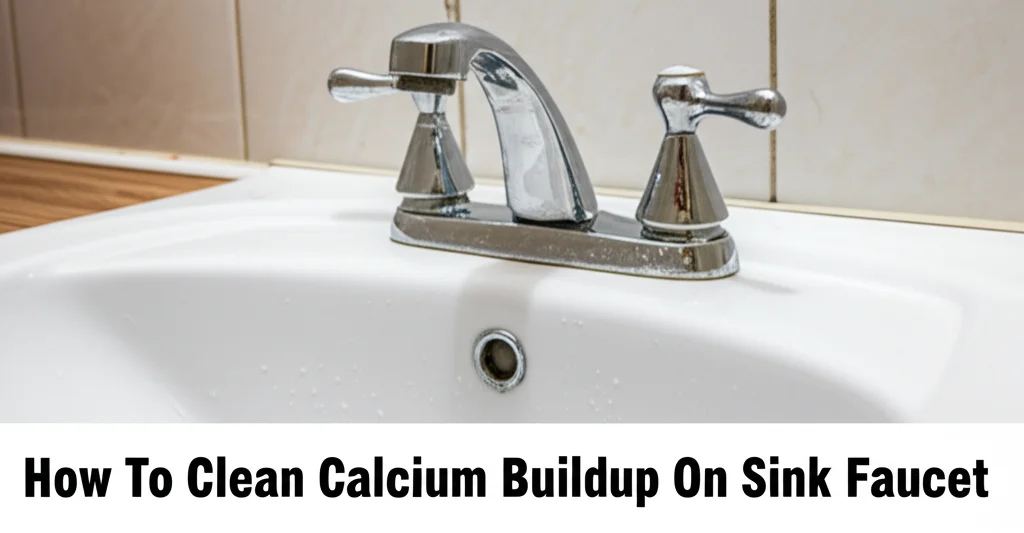· Home Cleaning · 6 min read
How To Clean Calcium Buildup On Sink Faucet

Sparkling Clean: How To Clean Calcium Buildup On Sink Faucet
Is your once-shiny sink faucet looking dull and crusty? You’re likely dealing with calcium buildup, a common problem caused by hard water. Don’t worry, restoring your faucet’s shine doesn’t require expensive cleaners or a plumber. This article will guide you through several effective methods to remove calcium buildup from your sink faucet, leaving it looking brand new. We’ll cover everything from simple vinegar soaks to more targeted cleaning techniques. Let’s get started and bring back the sparkle to your kitchen or bathroom!
Quick Answer: To clean calcium buildup on a sink faucet, soak a cloth in white vinegar, apply it to the affected areas, let it sit for 30-60 minutes, then scrub with a soft brush and rinse thoroughly.
Takeaway:
- Vinegar is your best friend for dissolving calcium.
- Gentle scrubbing prevents damage to the faucet finish.
- Regular cleaning prevents severe buildup.
Understanding Calcium Buildup & Why It Happens
Have you ever noticed those white, chalky deposits around your faucets? That’s calcium buildup, and it’s more than just unsightly. Calcium buildup occurs when hard water, water containing high mineral content, evaporates. As the water disappears, it leaves behind calcium and magnesium deposits. These minerals accumulate over time, forming a stubborn layer on your faucet.
This buildup isn’t just cosmetic; it can also affect your faucet’s performance. A thick layer of calcium can restrict water flow and even damage the faucet’s internal components. Knowing this, regular cleaning isn’t just about aesthetics – it’s about maintaining the longevity of your plumbing. Preventing buildup is easier than removing it, so consider a water softener if you live in an area with particularly hard water.
The Power of Vinegar: A Simple Cleaning Solution
White vinegar is a cleaning powerhouse, and it’s particularly effective against calcium buildup. The acetic acid in vinegar dissolves the mineral deposits, making them easier to remove. It’s also a natural, non-toxic option, making it safe for your family and the environment. You likely already have a bottle in your pantry, making it a convenient and cost-effective solution.
Here’s how to use vinegar to clean your faucet:
- Soak a cloth: Saturate a clean cloth or paper towel with white vinegar.
- Apply to faucet: Wrap the vinegar-soaked cloth around the affected areas of the faucet.
- Let it sit: Allow the vinegar to sit for 30-60 minutes, or even longer for stubborn buildup.
- Scrub gently: Remove the cloth and scrub the faucet with a soft brush, like an old toothbrush.
- Rinse thoroughly: Rinse the faucet with clean water and dry with a soft cloth.
For a more concentrated approach, you can also fill a plastic bag with vinegar and secure it around the faucet head with a rubber band, ensuring the faucet is fully submerged.
Baking Soda Boost: Enhancing Vinegar’s Cleaning Power
Sometimes, vinegar alone isn’t enough to tackle tough calcium buildup. That’s where baking soda comes in. Baking soda is a mild abrasive that helps to loosen and scrub away stubborn deposits. When combined with vinegar, it creates a fizzing action that further breaks down the calcium.
Here’s how to use baking soda and vinegar together:
- Make a paste: Mix baking soda with a small amount of vinegar to form a paste.
- Apply the paste: Apply the paste to the calcium buildup on the faucet.
- Let it sit: Allow the paste to sit for 15-20 minutes.
- Scrub gently: Scrub the faucet with a soft brush or sponge.
- Rinse thoroughly: Rinse the faucet with clean water and dry with a soft cloth.
Remember to test the paste on an inconspicuous area of the faucet first to ensure it doesn’t damage the finish. If you’re looking for more ways to utilize baking soda, check out https://www.beacleaner.com/how-to-remove-baking-soda-residue-from-carpet/ for helpful tips.
Lemon Juice: A Fresh-Scented Alternative
If you dislike the smell of vinegar, lemon juice is a great alternative. Lemon juice contains citric acid, which, like acetic acid in vinegar, effectively dissolves calcium buildup. It also leaves behind a fresh, citrusy scent.
The process is similar to using vinegar:
- Apply lemon juice: Saturate a cloth with lemon juice and apply it to the affected areas.
- Let it sit: Allow the lemon juice to sit for 30-60 minutes.
- Scrub gently: Scrub the faucet with a soft brush.
- Rinse thoroughly: Rinse the faucet with clean water and dry with a soft cloth.
You can also cut a lemon in half and rub it directly onto the calcium buildup.
Dealing with Aerators and Faucet Heads
Calcium buildup often accumulates inside the faucet aerator and head, restricting water flow. Removing and cleaning these parts is crucial for restoring optimal performance.
- Remove the aerator: Unscrew the aerator from the faucet spout.
- Disassemble: Carefully disassemble the aerator into its individual parts.
- Soak in vinegar: Soak the parts in white vinegar for at least 30 minutes.
- Scrub and rinse: Scrub the parts with a small brush to remove any remaining buildup, then rinse thoroughly with water.
- Reassemble: Reassemble the aerator and screw it back onto the faucet.
For stubborn buildup inside the faucet head, you can try flushing it with vinegar. Remove the faucet head and run vinegar through it for a few minutes.
Preventing Future Calcium Buildup
Once you’ve cleaned your faucet, you’ll want to prevent calcium buildup from returning. Here are a few tips:
- Wipe down regularly: Wipe down your faucet with a clean, dry cloth after each use.
- Use a water softener: If you have hard water, consider installing a water softener to reduce the mineral content.
- Apply a protective coating: Apply a thin coat of car wax or mineral oil to the faucet to create a protective barrier.
- Regular vinegar soak: Periodically soak a cloth in vinegar and wrap it around the faucet overnight to prevent buildup.
Maintaining a consistent cleaning routine will save you time and effort in the long run. If you’re also concerned about maintaining other areas of your home, you might find information on cleaning vinyl plank flooring helpful: https://www.beacleaner.com/how-to-clean-luxury-vinyl-plank-flooring/.
FAQ: Your Calcium Buildup Questions Answered
Q: Will vinegar damage my faucet’s finish?
A: Vinegar is generally safe for most faucet finishes, but it’s always best to test it on an inconspicuous area first. Avoid using vinegar on gold-plated faucets, as it can tarnish the finish.
Q: How often should I clean calcium buildup?
A: The frequency depends on the hardness of your water. If you have very hard water, you may need to clean your faucet weekly. Otherwise, monthly cleaning should suffice.
Q: Can I use abrasive cleaners?
A: Avoid using abrasive cleaners, as they can scratch and damage the faucet’s finish. Stick to gentle cleaning solutions like vinegar, lemon juice, and baking soda.
Q: What if the buildup is extremely stubborn?
A: For extremely stubborn buildup, you may need to repeat the cleaning process several times or use a commercial calcium remover specifically designed for faucets.
Conclusion: A Sparkling Faucet is Within Reach
Cleaning calcium buildup from your sink faucet is a simple task that can significantly improve its appearance and functionality. By using readily available ingredients like vinegar, baking soda, and lemon juice, you can easily remove those unsightly deposits and restore your faucet’s shine. Remember that regular cleaning and preventative measures are key to keeping your faucet looking its best. Don’t let calcium buildup dull your kitchen or bathroom – take action today and enjoy a sparkling clean faucet! If you found this guide helpful, share it with friends and family who might also be struggling with hard water stains.




